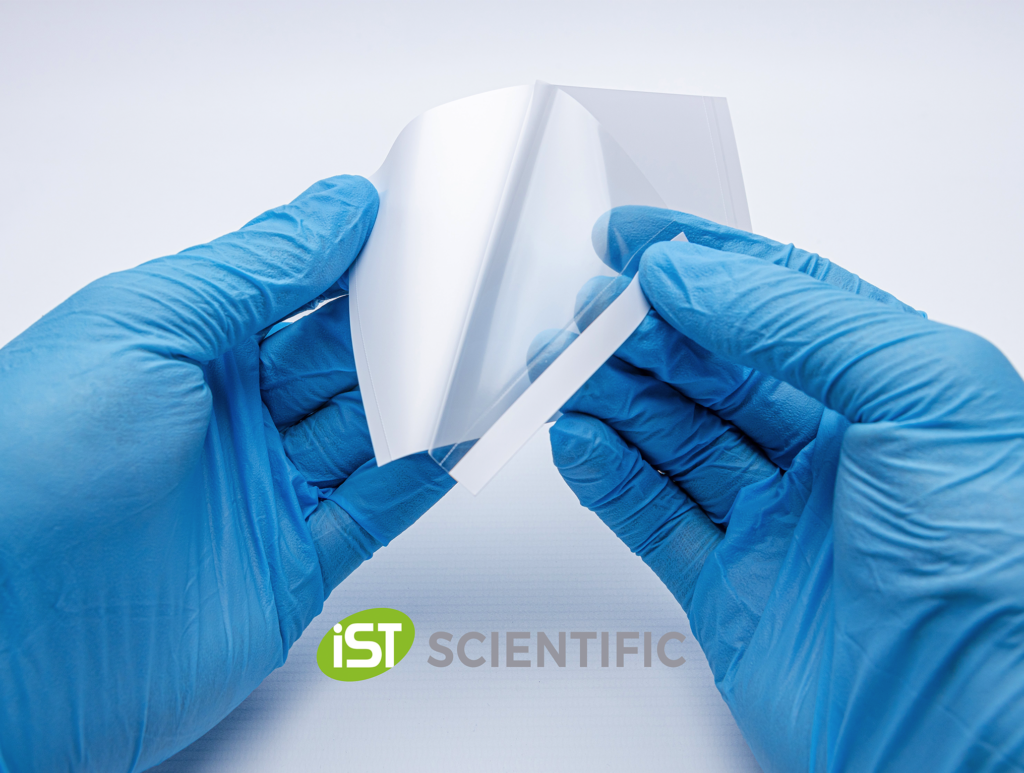How to use self-adhesive films.
Microplates are an essential tool in many scientific laboratories, particularly for applications such as cell culture, immunoassays, and high-throughput screening. While there are many types of microplates available, one common challenge researchers face is how to effectively seal and protect the contents of each well. This is where self-adhesive sealing films come in.
Sealing films seal microplates and prevent the evaporation of liquids or gases, which can affect the results of experiments. There are a variety of different sealing films available, each with its own advantages and disadvantages.
In this blog, we will discuss how to use self-adhesive sealing films for microplates with easy-to-follow steps.
Step 1. Choosing the Right Self-Adhesive Film for Microplates
The first step in using self-adhesive sealing films for microplates is to choose the right type of film for your application. There are several different types of self-adhesive sealing films available, each with its own unique properties and features.
Let’s take a look at some common types of self-adhesive sealing films used for microplates.
Different Types of Self-Adhesive Films
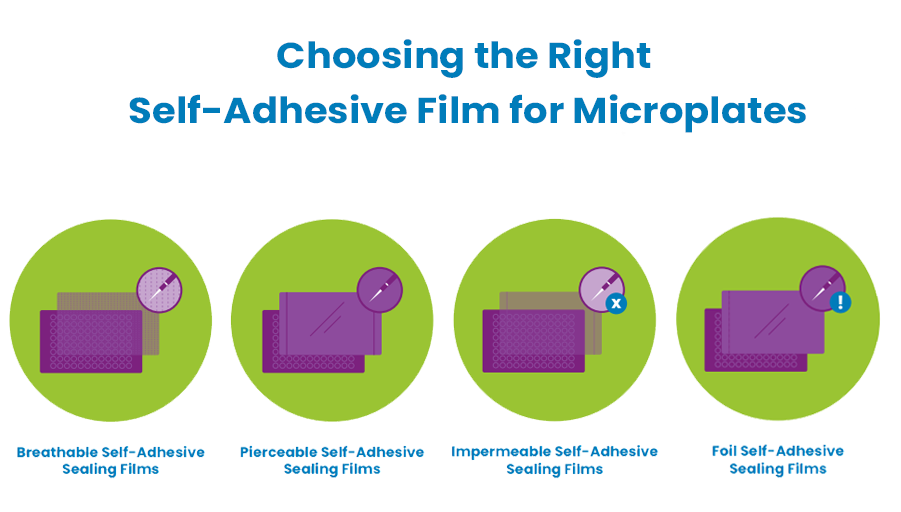
Breathable Self-Adhesive Sealing Films
Breathable Self-Adhesive Sealing Films are designed to allow gas exchange between the contents of the wells and the external environment. They are commonly used for cell culture applications.
Impermeable Self-Adhesive Sealing Films
Impermeable Self-Adhesive Sealing Films are designed to completely seal the wells, preventing contamination and evaporation. They are commonly used for storage applications.
Pierceable Self-Adhesive Sealing Films
Pierceable Self-Adhesive Sealing Films are designed to be easily pierced by needles or pipette tips, allowing for easy access to the contents of the wells without removing the film.
Foil Self-Adhesive Sealing Films
Foil Self-Adhesive Sealing Films are designed to provide a high level of protection and sealing for the contents of microplates in scientific laboratories. They are commonly used in applications that require a high level of protection against moisture, oxygen, and other gases, such as cell culture, immunoassays, and high-throughput screening.
Looking for different types of sealing films for microplates? Have a look at our article What Are The Different Types of Plate Sealing Films?
Tips for Choosing the Right Self-Adhesive Sealing Film for your Application
When choosing a self-adhesive sealing film, it is important to consider the specific requirements of your application. For example, if you are working with sensitive cell cultures, you may want to choose a breathable sealing film to ensure proper gas exchange. On the other hand, if you are storing samples for long periods of time, you may want to choose an impermeable sealing film to prevent evaporation and contamination.
Here are some tips for selecting the right self-adhesive sealing film for your needs:
- Determine the application temperature: Some self-adhesive films are designed to withstand high temperatures, while others are not. If you’re working with high-temperature applications, such as autoclaving, make sure to select a film that can withstand the heat.
- Check the film material: Self-adhesive films are available in various materials, including plastic, paper, and foil. The material you choose should be compatible with the contents of your application. For instance, if you’re sealing microplates containing chemicals or solvents, a plastic film may not be suitable as it could react with the contents.
- Consider the level of protection required: Different self-adhesive films offer varying levels of protection against moisture, oxygen, and other gases. If your application requires a high level of protection, a foil or laminated film will be more appropriate than a standard plastic film.
- Choose the correct format and size: Self-adhesive films come in different formats, such as rolls, pre-cut sheets, and die-cut shapes. It is essential to select the right format and size that will fit your application correctly.
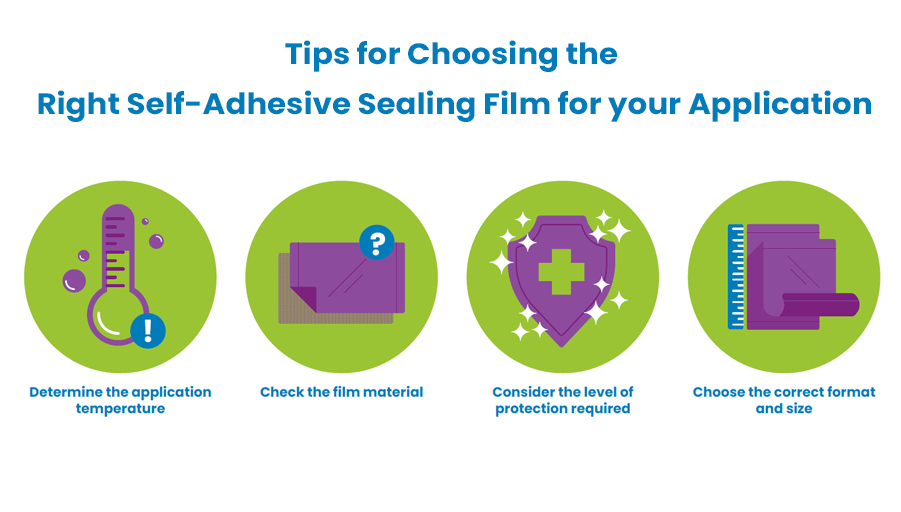
In conclusion, choosing the right self-adhesive film for your application requires careful consideration of various factors. By considering adhesive strength, application temperature, film material, level of protection required, and correct format and size, you can select a self-adhesive film that will meet your specific needs and deliver the desired results.
Step 2. Preparation of the Microplate
Once you have chosen the right self-adhesive sealing film for your microplate, the next step is to prepare the plate for application. This involves cleaning and sterilising the microplate, as well as filling the wells with the desired contents. It is important to ensure that the microplate is completely dry before applying the film, as any moisture can interfere with the adhesive properties of the film.
Preparing the microplate properly is an important step in ensuring the accuracy and reliability of your results.
Cleaning and Sterilising the Microplate
Start by cleaning the microplate thoroughly to remove any debris, dust, or residues that may interfere with your experiment. Use a mild detergent or an alcohol-based solution to clean the microplate, and rinse it with distilled water to remove any residue. Ensure that the microplate is completely dry before proceeding.
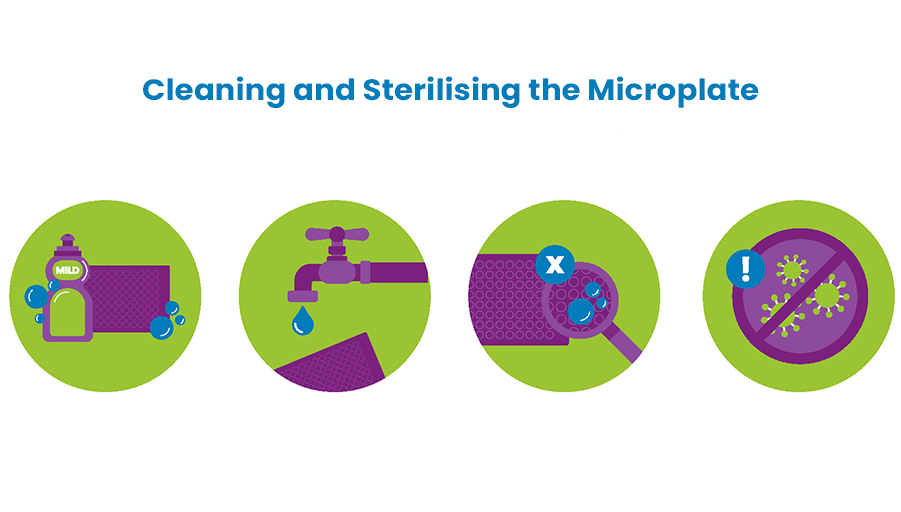
To minimise the risk of contamination, it is crucial to sterilise the microplate before use. You can sterilise the microplate by autoclaving, dry heat sterilisation, or chemical disinfection. Follow the manufacturer’s instructions carefully to ensure that the sterilisation process is effective.
Filling the Microplate Wells with the Desired Contents
Once the microplate is clean and sterile, you can start filling the wells with the desired contents. Use a pipette or a dispenser to ensure that the correct volume is added to each well. Take care not to overfill the wells, as this can cause spillage and contamination.
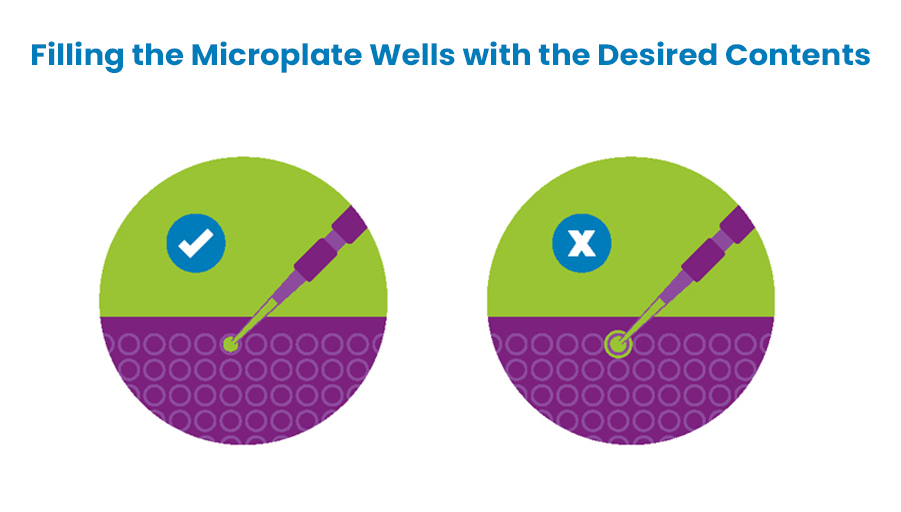
Drying the Microplate
After filling the wells, allow the microplate to dry completely. Any moisture left on the microplate can interfere with the adhesive properties of the film, leading to a weak seal and possible contamination.
Proper preparation of the microplate is critical for the success of your experiment. Cleaning and sterilising the microplate, filling the wells with the desired contents, and ensuring that the microplate is completely dry before applying the self-adhesive film will help to ensure a strong and reliable seal. By following these steps carefully, you can improve the accuracy and reliability of your experimental results.
The next step is applying the self-adhesive sealing film.
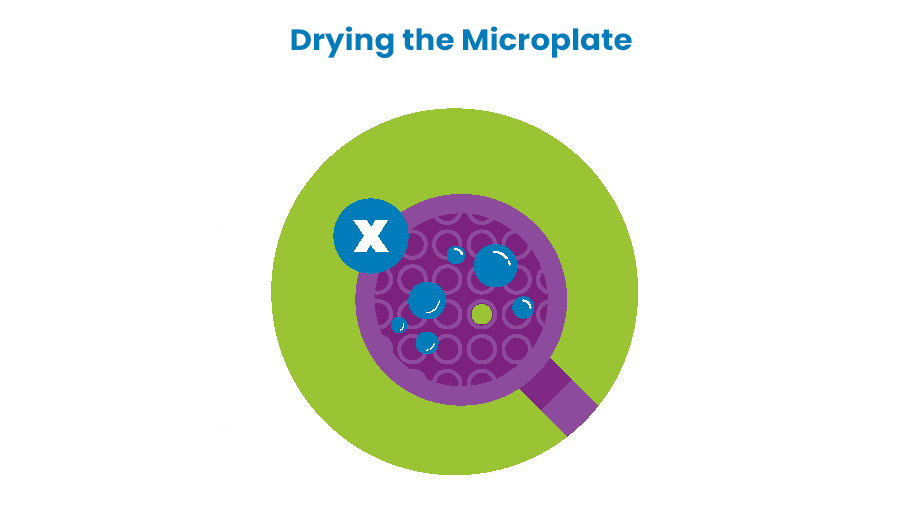
Step 3. Application of the Self-Adhesive Sealing Film
Now that your microplate is ready, it is time to apply the self-adhesive film. The process for applying the film will depend on the specific type of film you are using, but some general tips include:
- Start in the centre of the microplate and work your way outwards, pressing the film down firmly as you go.
- Use a roller or pipette tip to smooth out any air bubbles or wrinkles in the film.
- If using a breathable film, ensure that the film is securely sealed around the edges of the microplate to prevent any air leaks.
Tips for Ensuring the Self-Adhesive Sealing Film is Applied Correctly
Applying the self-adhesive sealing film to the microplate correctly is crucial for ensuring a strong and reliable seal. Here are some tips to help ensure that the film is applied correctly:
- Align the film carefully: Before applying the film, align it carefully with the microplate to ensure that it covers each well completely. Take care not to touch the adhesive side of the film with your fingers, as this can leave oil or dirt on the film, which can interfere with the adhesive properties.
- Use a roller to apply the film: To ensure that the film is applied evenly and smoothly, use a roller to press down firmly on the film. A roller helps to remove any air bubbles or wrinkles that may form during the application process. If you don’t have a roller, you can use a flat object such as a credit card or a ruler to smooth out the film.
- Apply the film at room temperature: Self-adhesive films are designed to be applied at room temperature. Applying the film in a cold environment can make it stiff and difficult to apply, while applying it in a hot environment can cause the adhesive to melt and lose its properties.
- Ensure the film is fully sealed: After applying the film, check to ensure that it is fully sealed around the edges of each well. A weak or incomplete seal can lead to evaporation, contamination, and inaccurate results.
- Store the microplate properly: Once the film is applied, store the microplate in a suitable environment to ensure that the contents remain stable and protected. Depending on the contents, this may involve storing the microplate in a dark, cool, or dry environment.
By following these tips, you can ensure that the self-adhesive film is applied correctly and that the microplate is sealed effectively. A strong and reliable seal helps to minimise the risk of contamination, evaporation, and other issues that can compromise the accuracy and reliability of your experimental results.
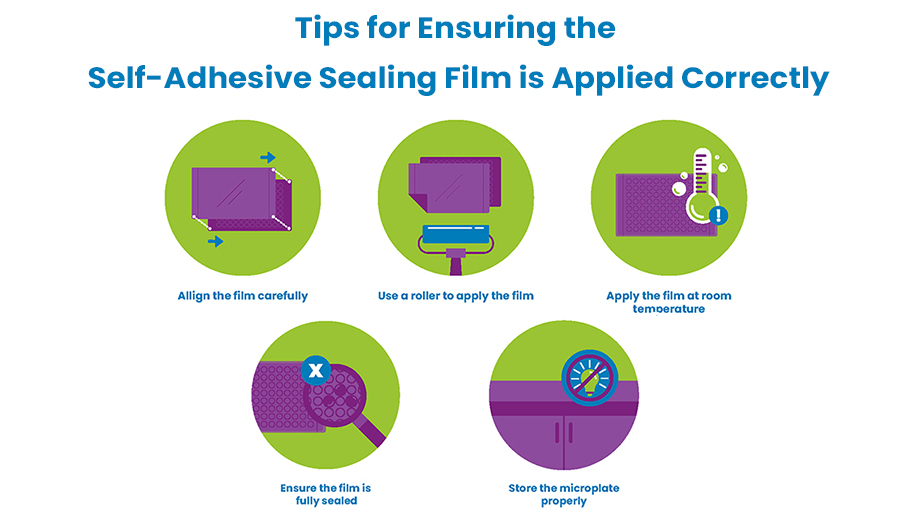
Step 4. Removing the Self-Adhesive Sealing Film
When it is time to remove the self-adhesive film from the microplate, it is important to do so carefully to minimise the risk of contamination. Some tips for removing the film include:
- Peel the film away slowly: Start by peeling the film away from one corner of the microplate, using a slow and steady motion. Take care not to apply too much force, as this can cause the contents of the wells to splash or spill.
- Avoid touching the contents: As you peel the film away, be careful not to touch the contents of the wells. Any contamination can interfere with the accuracy and reliability of the results.
- Dispose of the film properly: After the film is removed, dispose of it in a biohazard waste container to prevent contamination.
- Clean and sterilise the microplate: If you plan to reuse the microplate, it is essential to clean and sterilise it thoroughly before applying a new self-adhesive film. This helps to prevent any residual contamination from previous experiments or analyses.
By following these tips, you can ensure that the self-adhesive film is removed safely and effectively, minimising the risk of contamination and spills. This helps to maintain the integrity of your experimental results and ensures that your laboratory stays safe and clean.
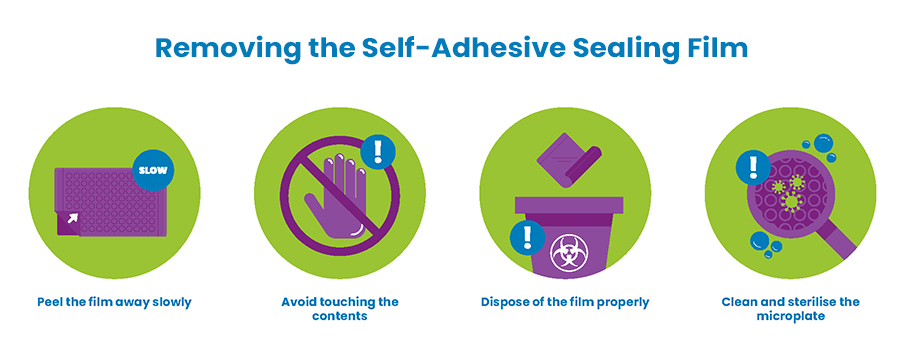
Tips for Minimising the Risk of Contamination During Sealing Film Removal
Contamination is a significant concern when it comes to removing self-adhesive films from microplates, especially if the contents of the wells are hazardous or sensitive to contamination. Here are some tips for minimising the risk of contamination during film removal:
- Wear appropriate personal protective equipment (PPE): Before removing the film, ensure that you are wearing the necessary PPE, including gloves, a lab coat, and safety goggles. This protects you from any hazardous substances that may be present in the wells.
- Use a slow and steady motion: Avoid peeling the film too quickly or aggressively, as this can cause the contents of the wells to splash or spill, increasing the risk of contamination. Instead, use a slow and steady motion to remove the film.
- Use a clean and dedicated workspace: Ensure that you have a clean and dedicated workspace for removing the film. This helps to prevent cross-contamination from other materials or equipment in the laboratory.
- Sterilise the microplate before and after film removal: To prevent contamination from previous experiments, it is essential to sterilise the microplate before and after film removal. This helps to eliminate any residual contamination that may be present on the surface of the plate.
By following these tips, you can minimise the risk of contamination during film removal, ensuring that your laboratory stays clean and safe, and that your experimental results are accurate and reliable.
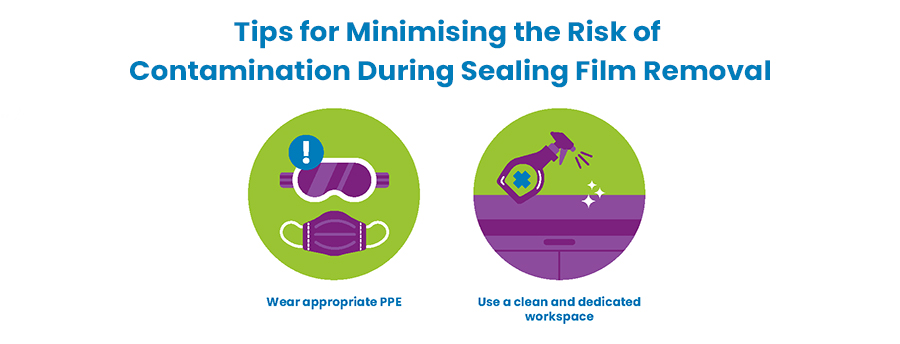
Choosing the Right Self-Adhesive Sealing Film for Microplates
Self-adhesive films are an essential tool for sealing and protecting the contents of microplates in scientific laboratories. By following these easy-to-follow steps for using self-adhesive films for microplates, you can ensure that your experiments are conducted in a clean and controlled environment, leading to more accurate and reliable results.
In conclusion, using self-adhesive films for microplates is a simple and effective way to protect and seal the contents of each well. By following the steps outlined in this blog, you can ensure that you:
- choose the right sealing film for your application
- prepare the microplate correctly
- apply the sealing film accurately
- and remove the sealing film safely.
By minimising the risk of contamination, you can ensure the accuracy and reliability of your experimental results. If you have any questions or would like to learn more about our self-adhesive films for microplates, please feel free to contact iST Scientific. We are happy to help you find the right solution for your laboratory needs.
At iST Scientific, our team of professionals have expertise in microplate sealing films and related materials used in laboratory research applications.
We understand the unique needs of each application and can provide tailored solutions for specific sample types or protocols. We take into consideration factors such as reversibility, temperature stability, optical clarity and adhesive strength when recommending individual microplate sealing films for use in laboratory workflows.
At iST Scientific, we carry a wide selection of plate-sealing films in various forms to meet your needs. Our products include heat-sealable and self-adhesive plate sealing films as well as solvent-resistant and foil plate sealing films.
Explore our expansive selection available to find the perfect solution for your laboratory requirements.

